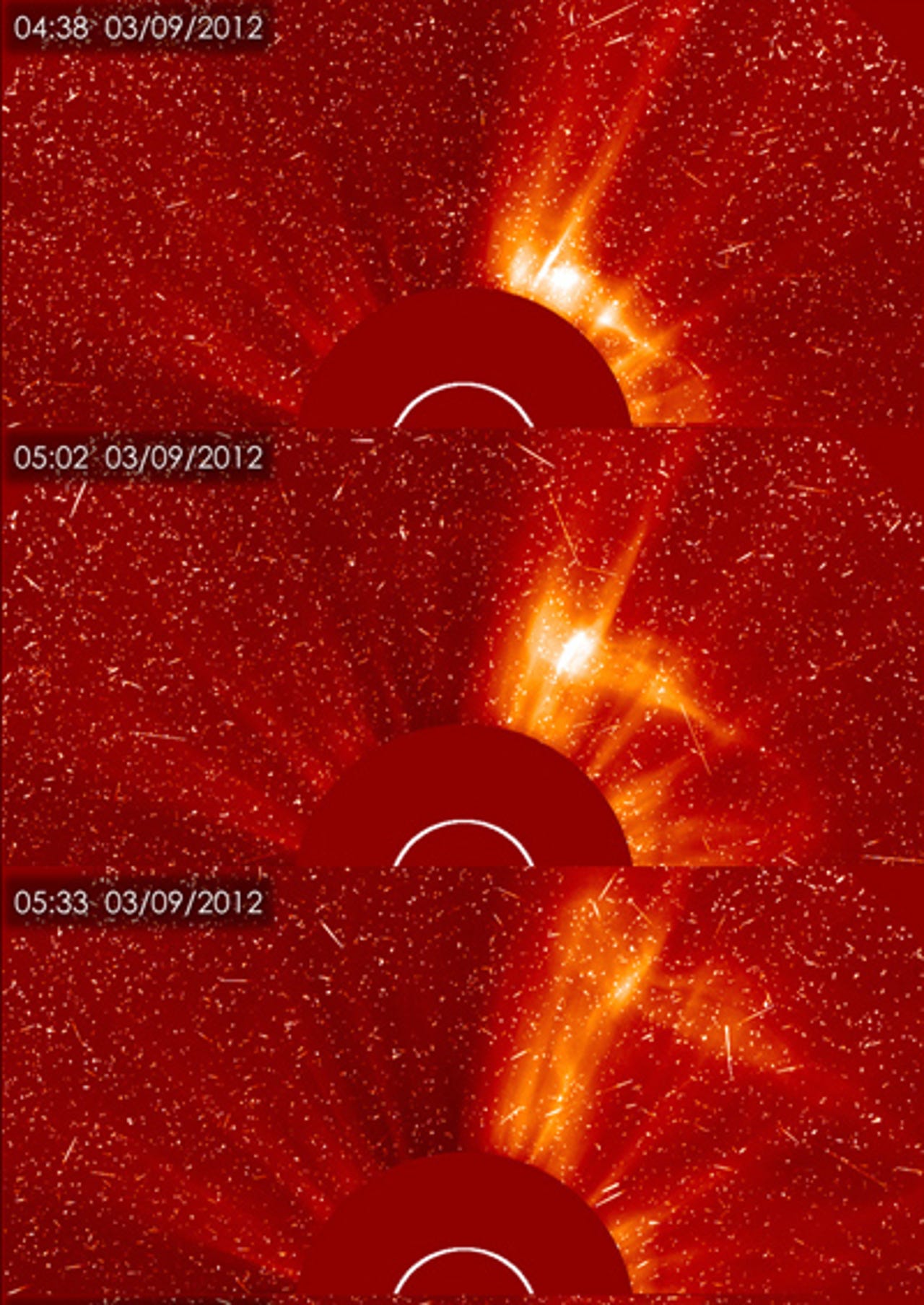Sun spot causing storms on Earth


UPDATED 3/12/12 7:30 a.m. ET. Trouble with your GPS? Your computer is mysteriously rebooting? Your cell phone isn't working? It could be due to the effects of a solar storm. Sunspot 1429 has sent 3 coronal mass ejections (CMEs) and at least 3 solar flares in the past week.
On March 8 at at 10:53 p.m. ET the sun discharged an M6.3 class solar flare, and about an hour later released a coronal mass ejection. The lastest CME is expected to trigger solar storms of moderate intensity (G2) on March 12 and March 13.
On Thursday NASA reported that two CMEs from the sun hit Earth at around 5:45 a.m. PT. Originally it was thought that the two CMEs would cause the worst solar storm in five years but fortunately that was not the case.
The National Weather Service's Space Weather Prediction Center said the solar storm caused by the CMEs did reach a S3 (severe) level overnight Thursday and into Friday morning. But has leveled off.
A solar flare is "an intense burst of radiation coming from the release of magnetic energy associated with sunspots. Flares are our solar system’s largest explosive events," according to NASA
A coronal mass ejection happens when strong magnetic fields in the sun's carona "are closed, the confined solar atmosphere can suddenly and violently release bubbles of gas and magnetic fields called coronal mass ejections," according to NASA. CMEs can send billions of tons of matter at millions of miles per hour.
The images above show the formation of the CME on March 8. It is now heading toward Earth.
Credit: SOHO/ESA & NASA
NASA reported that two coronal mass ejections (CMEs) discharged from the sun on Wednesday March 6, 2012 and reached Earth at 5:45 a.m. ET on Thurday March 8. The two CMEs were traveling at 1,300 and 1,100 miles per second. Initial reports said they could cause the largest solar storm in five years. But that turned out not to be the case.
Here's a photo of the actual CME leaving the sun on March 6.
This is sunspot 1429 which is responsible for sending 3 coronal mass ejections and 1 solar flare toward the Earth - and it's still growing. It is now 7 times larger than Earth.
Credit: NASA/SDO/HMI
NASA says one of the solar flares is the second largest of the current 11 year cycle of solar activity and is categorized as X5.4. It's partner was categorized as a 1.3X. The largest solar flare of the current cycle struck Earth on August 10, 2011.
Don't feel too secure as the maximum activity on the current solar cycle will not occur until late 2013.
The sun on March 6, 2012. Credit: NASA
How do solar storms affect life on Earth? NASA gives this explanation:
"Strong electrical currents driven along the Earth’s surface during auroral events disrupt electric power grids and contribute to the corrosion of oil and gas pipelines. Changes in the ionosphere during geomagnetic storms interfere with high-frequency radio communications and Global Positioning System (GPS) navigation. During polar cap absorption events caused by solar protons, radio communications can be compromised for commercial airliners on transpolar crossing routes. Exposure of spacecraft to energetic particles during solar energetic particle events and radiation belt enhancements cause temporary operational anomalies, damage critical electronics, degrade solar arrays, and blind optical systems such as imagers and star trackers."
And don't forget the astronauts.
Following is a gallery of sun activity in the last decade. Some pretty amazing pictures.
The Solar Dynamics Observatory watched this solar flare erupting from the sun on January 22, 2012. The "solar energetic particles" which erupted from the sun are traveling at a speed of 1,400 miles per second and hit Earth on January 24.
A massive solar eruption from March 30, 2010 is shown here with the a comparison to the size of the Earth.
Credit: NASA/SDO
An 8.7 class coronal mass ejection was sent streaming toward Earth on January 22, 2012.. This video shows the sun's activity from January 19-23. At the end of the clip you can see interference from the storm.
Credit: SOHO/ESA & NASA
The Solar and Heliospheric Observatory (SOHO) and NASA's Stereo-B spacecraft both observed this large coronal mass ejection (CME) coming from sun.
These loops made of super heated plasma were observed after a solar flare erupted on January 15-16, 2012. One is the size of several Earths.
Credit: SDO
Here's a current look at the pockets of magnetic activity on the sun.
Aurora's are caused by solar flares hitting the Earth's atmosphere. If it's dark, go outside, you might see one.
This one was captured by an astronaut in the International Space Station of May 29, 2010.
Coronal holes are large, dark areas of the sun (viewed by x-ray wavelengths). Their open field lines allow a continuous outflow of high-speed solar wind far out into the solar system..
Credit: SOHO EIT, ESA/NASA
Solar flares impact Earth when they occur on the half of the sun that is facing our planet. This flare is from July 1, 2002.
Credit: SOHO, ESA & NASA
Conditions on our sun is constantly changing in a cycle that lasts 11 earth years.
Credit: SOHO EIT, ESA/NASA
This image shows activity on the sun.
A medium-sized sunspot is about the size of the Earth. A sunspot is an area of high magnetic activity that come and go. They are often the sites of solar flares.